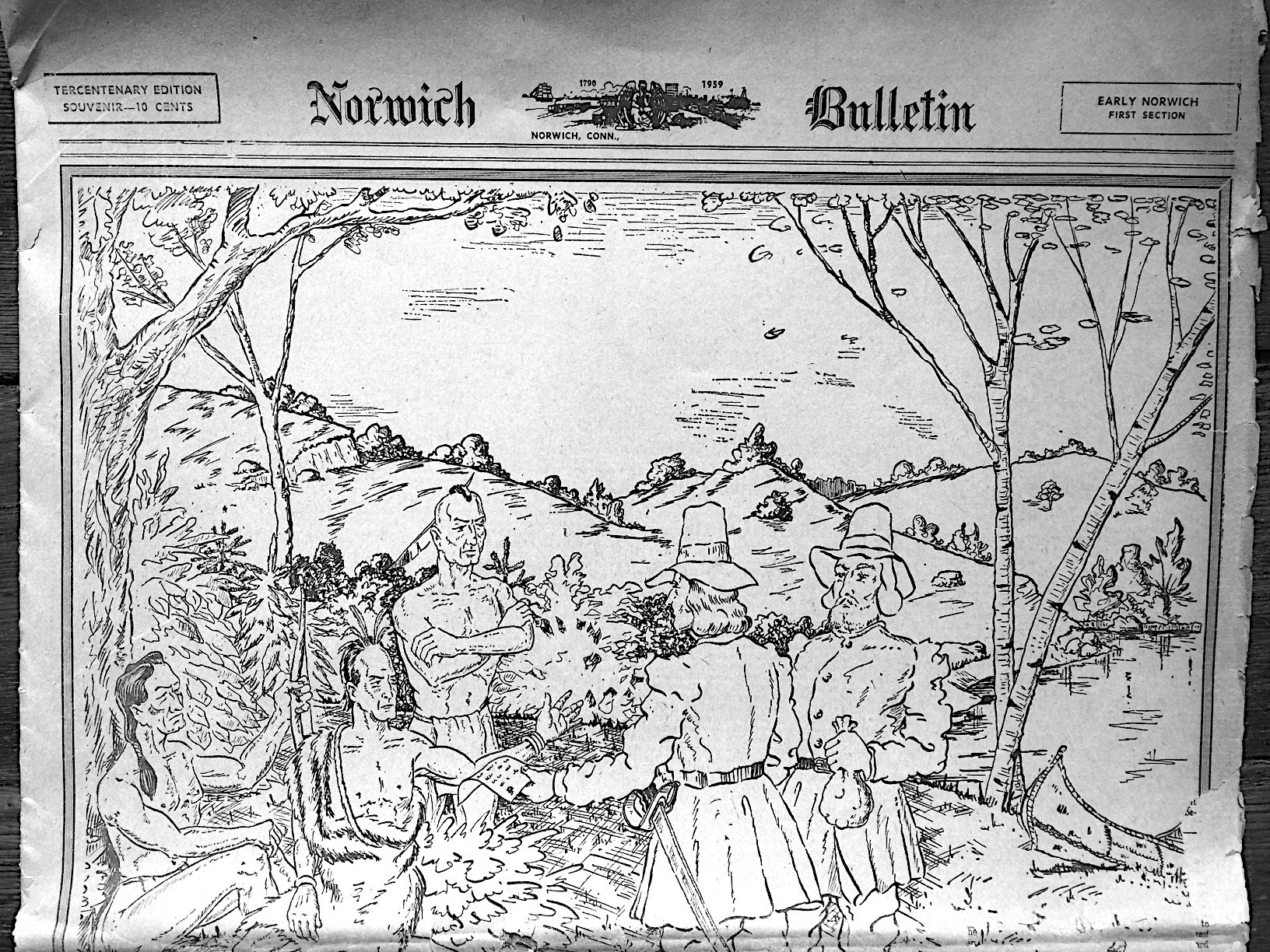|
Joseph Carpenter Silversmith Shop
The Joseph Carpenter Silversmith Shop is a historic building that was built between 1772 and 1774 on the green in Norwichtown, now a section of Norwich, Connecticut. It is a by -story clapboarded building with a gambrel roof. The interior has a single brick chimney that was used for the forge, but it has been modified and adapted for modern use with modern doors, electric lighting and heat, and a disappearing overhead stairway that leads to the attic. Joseph Carpenter (1747–1804) was a successful of silversmith, clockmaker, and pewterer, and shared the building with his brother, a merchant. The shop was added to the National Register of Historic Places on October 6, 1970, and was listed as a contributory property for the Norwichtown Historic District on January 17, 1973. Original occupants Born in 1747 to Joseph and Elizabeth Carpenter (née Lathrop), Joseph Carpenter was a successful silversmith in Norwich, Connecticut. The shop was constructed between 1772 and 1774 and Jose ... [...More Info...] [...Related Items...] OR: [Wikipedia] [Google] [Baidu] |
Norwich, Connecticut
Norwich ( ) (also called "The Rose of New England") is a city in New London County, Connecticut, United States. The Yantic, Shetucket, and Quinebaug Rivers flow into the city and form its harbor, from which the Thames River flows south to Long Island Sound. The population was 40,125 at the 2020 United States Census. History The town of Norwich was founded on the site of what is now Norwichtown in 1659 by settlers from Saybrook Colony led by Major John Mason and James Fitch. They purchased the land "nine miles square" that became Norwich from Mohegan Sachem Uncas. One of the co-founders of Norwich was Thomas Leffingwell who rescued Uncas when surrounded by his Narragansett enemies, and whose son established the Leffingwell Inn. In 1668, a wharf was established at Yantic Cove. Settlement was primarily in the area around the Norwichtown Green. The 69 founding families soon divided up the land in the Norwichtown vicinity for farms and businesses. By 1694, the public landing bu ... [...More Info...] [...Related Items...] OR: [Wikipedia] [Google] [Baidu] |
Norwichtown Historic District
Norwichtown is a historic neighborhood in the city of Norwich, Connecticut. It is generally the area immediately north of the Yantic River between I-395 and Route 169. The portion of the neighborhood from the Norwichtown Green and east of it is a locally designated historic district that was also listed on the National Register of Historic Places in 1973 as the Norwichtown Historic District. The district includes 48 contributing buildings and one other contributing site over area. The earliest settlement of Norwich, in 1659, was in Norwichtown. Initial settlement, by 35 English settlers who relocated froSaybrook Fortunder the leadership of Major John Mason and bought land from Uncas, sachem of the Mohegans, was centered on the Norwichtown Green.Carol Davidge and Erwin Goldstein, "Norwichtown Green & Old Burying Grounds,Walking Guide to the Quinebaug and Shetucket Rivers Valley National Heritage Corridor page 5 History The Green is triangular in shape, with an area of abo ... [...More Info...] [...Related Items...] OR: [Wikipedia] [Google] [Baidu] |
Norwichtown, Connecticut
Norwichtown is a historic neighborhood in the city of Norwich, Connecticut. It is generally the area immediately north of the Yantic River between I-395 and Route 169. The portion of the neighborhood from the Norwichtown Green and east of it is a locally designated historic district that was also listed on the National Register of Historic Places in 1973 as the Norwichtown Historic District. The district includes 48 contributing buildings and one other contributing site over area. The earliest settlement of Norwich, in 1659, was in Norwichtown. Initial settlement, by 35 English settlers who relocated froSaybrook Fortunder the leadership of Major John Mason and bought land from Uncas, sachem of the Mohegans, was centered on the Norwichtown Green.Carol Davidge and Erwin Goldstein, "Norwichtown Green & Old Burying Grounds,Walking Guide to the Quinebaug and Shetucket Rivers Valley National Heritage Corridor page 5 History The Green is triangular in shape, with an area of ab ... [...More Info...] [...Related Items...] OR: [Wikipedia] [Google] [Baidu] |
National Register Of Historic Places
The National Register of Historic Places (NRHP) is the United States federal government's official list of districts, sites, buildings, structures and objects deemed worthy of preservation for their historical significance or "great artistic value". A property listed in the National Register, or located within a National Register Historic District, may qualify for tax incentives derived from the total value of expenses incurred in preserving the property. The passage of the National Historic Preservation Act (NHPA) in 1966 established the National Register and the process for adding properties to it. Of the more than one and a half million properties on the National Register, 95,000 are listed individually. The remainder are contributing resources within historic districts. For most of its history, the National Register has been administered by the National Park Service (NPS), an agency within the U.S. Department of the Interior. Its goals are to help property owners and inte ... [...More Info...] [...Related Items...] OR: [Wikipedia] [Google] [Baidu] |
Gambrel Roof
A gambrel or gambrel roof is a usually symmetrical two-sided roof with two slopes on each side. (The usual architectural term in eighteenth-century England and North America was "Dutch roof".) The upper slope is positioned at a shallow angle, while the lower slope is steep. This design provides the advantages of a sloped roof while maximizing headroom inside the building's upper level and shortening what would otherwise be a tall roof. The name comes from the Medieval Latin word ''gamba'', meaning horse's hock or leg. The term ''gambrel'' is of American origin, the older, European name being a curb (kerb, kirb) roof. Europeans historically did not distinguish between a gambrel roof and a mansard roof but called both types a mansard. In the United States, various shapes of gambrel roofs are sometimes called Dutch gambrel or Dutch Colonial gambrel with bell-cast eaves, Swedish, German, English, French, or New England gambrel. The cross-section of a gambrel roof is similar to tha ... [...More Info...] [...Related Items...] OR: [Wikipedia] [Google] [Baidu] |
Historic American Buildings Survey
Heritage Documentation Programs (HDP) is a division of the U.S. National Park Service (NPS) responsible for administering the Historic American Buildings Survey (HABS), Historic American Engineering Record (HAER), and Historic American Landscapes Survey (HALS). These programs were established to document historic places in the United States. Records consist of measured drawings, archival photographs, and written reports, and are archived in the Prints and Photographs Division of the Library of Congress. Historic American Buildings Survey In 1933, NPS established the Historic American Buildings Survey following a proposal by Charles E. Peterson, a young landscape architect in the agency. It was founded as a constructive make-work program for architects, draftsmen and photographers left jobless by the Great Depression. It was supported through the Historic Sites Act of 1935. Guided by field instructions from Washington, D.C., the first HABS recorders were tasked with documen ... [...More Info...] [...Related Items...] OR: [Wikipedia] [Google] [Baidu] |
National Register Of Historic Places Listings In New London County, Connecticut
__NOTOC__ This is a list of the National Register of Historic Places listings in New London County, Connecticut. This is intended to be a complete list of the properties and districts on the National Register of Historic Places in New London County, Connecticut, United States. The locations of National Register properties and districts for which the latitude and longitude coordinates are included below, may be seen in an online map. There are 201 properties and districts listed on the National Register in the county, including 13 National Historic Landmarks. One property was once listed, but has since been delisted. Current listings Former listing See also *List of National Historic Landmarks in Connecticut * National Register of Historic Places listings in Connectic ... [...More Info...] [...Related Items...] OR: [Wikipedia] [Google] [Baidu] |
Carpenter House (Norwich, Connecticut)
The Carpenter House, also known as the Gardiner (Gardner) Carpenter House and the Red House, is a Georgian style house in Norwichtown area of Norwich, Connecticut. A house was previously on the site, but it was removed by Gardner Carpenter to construct the house in 1793. The three-story Flemish bond Georgian house's front facade consists of five bays with a gabled porch over the main entrance and supported by round columns. The gambrel roof and third story addition were added around 1816 by Joseph Huntington. In 1958, a modern one-story rear wing was added to the back of the house. The interior of the house is a center hall plan with high ceilings and has been renovated, but retains much of its original molding, paneling and wrought iron hardware. It was listed on the National Register of Historic Places in 1970 and added to the Norwichtown Historic District in 1973. History Historical records for Gardner Carpenter's life are sparse in detail, but the ''Vital records of N ... [...More Info...] [...Related Items...] OR: [Wikipedia] [Google] [Baidu] |
National Register Of Historic Places In New London County, Connecticut
__NOTOC__ This is a list of the National Register of Historic Places listings in New London County, Connecticut. This is intended to be a complete list of the properties and districts on the National Register of Historic Places in New London County, Connecticut, United States. The locations of National Register properties and districts for which the latitude and longitude coordinates are included below, may be seen in an online map. There are 201 properties and districts listed on the National Register in the county, including 13 National Historic Landmarks. One property was once listed, but has since been delisted. Current listings Former listing See also *List of National Historic Landmarks in Connecticut *National Register of Historic Places listings in Connecticu ... [...More Info...] [...Related Items...] OR: [Wikipedia] [Google] [Baidu] |
Historic American Buildings Survey In Connecticut
History (derived ) is the systematic study and the documentation of the human activity. The time period of event before the invention of writing systems is considered prehistory. "History" is an umbrella term comprising past events as well as the memory, discovery, collection, organization, presentation, and interpretation of these events. Historians seek knowledge of the past using historical sources such as written documents, oral accounts, art and material artifacts, and ecological markers. History is not complete and still has debatable mysteries. History is also an academic discipline which uses narrative to describe, examine, question, and analyze past events, and investigate their patterns of cause and effect. Historians often debate which narrative best explains an event, as well as the significance of different causes and effects. Historians also debate the nature of history as an end in itself, as well as its usefulness to give perspective on the problems of the p ... [...More Info...] [...Related Items...] OR: [Wikipedia] [Google] [Baidu] |
Buildings And Structures In Norwich, Connecticut
A building, or edifice, is an enclosed structure with a roof and walls standing more or less permanently in one place, such as a house or factory (although there's also portable buildings). Buildings come in a variety of sizes, shapes, and functions, and have been adapted throughout history for a wide number of factors, from building materials available, to weather conditions, land prices, ground conditions, specific uses, prestige, and aesthetic reasons. To better understand the term ''building'' compare the list of nonbuilding structures. Buildings serve several societal needs – primarily as shelter from weather, security, living space, privacy, to store belongings, and to comfortably live and work. A building as a shelter represents a physical division of the human habitat (a place of comfort and safety) and the ''outside'' (a place that at times may be harsh and harmful). Ever since the first cave paintings, buildings have also become objects or canvasses of much artis ... [...More Info...] [...Related Items...] OR: [Wikipedia] [Google] [Baidu] |



_Team.jpg)
.jpg)
